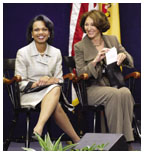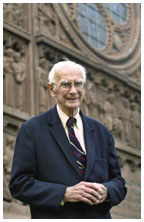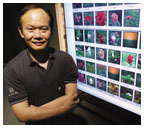
|
|
October 19, 2005: Notebook
WWS festivities draw Rice, Chertoff, Petraeus *87
Professor, alumni win MacArthur ‘genius’ grants
Faculty ‘moves the needle’ on grade deflation
Encouraging two-parent households
Breaking ground—Computer
science
New tools for Web searches
WWS festivities draw Rice, Chertoff, Petraeus *87
“Now is not the time to falter or fade” in Iraq, Secretary of State Condoleezza Rice said in her speech in Jadwin Gym. At right is Anne-Marie Slaughter ’80, dean of the Woodrow Wilson School. (Photos: Frank Wojciechowski, top; Kevin Birch, bottom)
Distributing pamphlets and red ribbons to protest the Bush administration’s policies in Africa were, from left, graduate student Kenneth Jamison, Hahna Fridirici ’06, and Zinzi Bailey ’06. |
Secretary of State Condoleezza Rice’s strong defense of America’s Iraq and Mideast policies on Sept. 30 highlighted a weekend of special events kicking off the 75th anniversary celebration of the Woodrow Wilson School.
Speaking before an audience of about 3,000 in Jadwin Gym, Rice provided a historical perspective for the Bush administration’s foreign policy, comparing present-day challenges to “extraordinary times” like those faced by America after World War II. “In a world where evil is still very real, democratic principles must be backed with power in all its forms,” she said: political, economic, cultural, moral, and military.
“The choice we face in Iraq is stark,” Rice said. To give up the fight now would not only abandon those supporting freedom in the country, she said, but would “embolden every enemy of liberty and democracy across the Middle East” and make the United States more vulnerable.
Her talk brought mixed reviews. “It was an excellent talk,” said Frederick P. Hitz ’61, lecturer in public and international affairs.
“It’s amazing that you can espouse those high ideals and then come to such different conclusions,” said Danielle Osler, a second-year graduate student and member of the Black Graduate Caucus. “No one’s saying that there can’t be democracy in Iraq, just that maybe you don’t need to bomb Iraq to get that.”
Rice’s visit drew generally low-key protests. The Student Global AIDS Campaign, the Black Graduate Caucus, and the College Democrats passed out more than 1,000 red ribbons as a sign of solidarity against U.S. policy in Africa, and a half-dozen protesters quietly held up placards at the rear of the upper-tier seats during her talk.
Community protesters who began at Palmer Square marched to join students outside the entrance of Jadwin, chanting to the beat of a drum and holding up signs protesting the Bush administration’s foreign policy.
Danilo Mandic ’07 burned his ticket to the speech. “If you are going to have Condoleezza Rice, then why not have Fidel Castro? Students are exposed to a very narrow spectrum of opinion, which does not encourage critical thinking,” he said.
Rice was one of three major speakers who appeared on campus in less than 24 hours as part of the Wilson School celebration, with Homeland Security Secretary Michael Chertoff and Lt. Gen. David Petraeus *87 appearing the following day.
Petraeus, who led the efforts to train and equip Iraq’s military and police forces from June 2004 until last month, summed up the effort to move Iraq’s security forces toward self-sufficiency as “tremendous progress, qualified optimism, still enormous work ahead.”
Asked by Wilson School Dean Anne-Marie Slaughter ’80 about how the United States “can restore the values we stand for in others’ eyes” in the wake of the Abu Ghraib prison scandal, Petraeus said there has been a great effort to improve the handling of detainees. “It’s all about cultural sensitivity, the tone that we set, which is magnified enormously in a combat environment,” he said.
Petraeus, who received master’s and doctoral degrees from the Wilson School, received a standing ovation from an overflow crowd in McCosh 50.
Chertoff spoke about the importance of international cooperation in dealing with terrorism, epidemics, and natural disasters.
He was asked “what specifically went wrong” with the government’s
efforts after Hurricane Katrina, and if the focus on terrorism has hurt
the response to natural disasters. “There is not enough time to
answer the first part of the question fully,” Chertoff said, drawing
a laugh from the audience. But he added that the rescue effort was complicated
by dealing with both the hurricane and the flooding that resulted from
breaks in the levees. To overlook those challenges, he said, “is
being unfair to everyone involved.” ![]()

Professor, alumni win MacArthur ‘genius’ grants
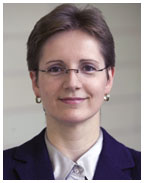
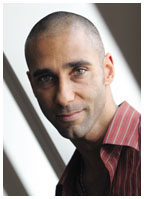
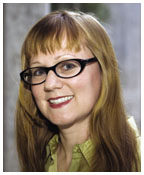
MacArthur grant winners, from left: Claire Gmachl, Fazal Sheikh ’87, and Emily Thompson *92. (Photographs courtesy John D. and Catherine T. Macarthur Foundation)
Engineering professor Claire Gmachl was at a conference on Cape Cod. Photographer Fazal Sheikh ’87 had just returned home to Zurich from the printing of his new book in Germany. History professor Emily Thompson *92 was working on the syllabus for her fall course at the University of California, San Diego. Then the phone rang for each one, bringing the news that they were among the 25 MacArthur Fellows for 2005 who will receive $500,000 each over the next five years.
“It was as though the Lone Ranger had just galloped from the phone receiver into my room to announce he was granting me a wish of security for the next set of years,” said Sheikh, 40, who was cited by the MacArthur Foundation for “using the personalizing power of portraiture to bring the faces of the world’s displaced people into focus.” Noting that funding for his kind of documentary work is declining, Sheikh said the award — widely known as the “genius grant” — “provides profound support in an atmosphere free of censorship.”
Thompson, 43, an associate professor of history who specializes in the history of sound technology, was cited for “charting the transformation of the elusive and ephemeral phenomenon of sound.” She said the grant will support her current project on the transition from silent to sound motion pictures and hopes it will help her afford “a little bungalow” in southern California.
Gmachl, an associate professor of electrical engineering, is 38. She was cited for her research in creating quantum cascade lasers, which could be used in fields from homeland security to environmental monitoring to clinical diagnostics. The foundation termed her a “wizard at imagining and creating new designs” for such devices. “By being creative, you can trick these new materials into doing something that is not available in nature,” Gmachl said.
Gmachl came to Princeton two years ago from Lucent Technologies, Bell Labs, where she was part of the group that built the first quantum cascade laser. “She has a clear vision, great ambition, and works very strategically to achieve her goals,” said Maria Klawe, dean of the School of Engineering and Applied Sciences.
Another 2005 MacArthur winner, Michael Walsh, took graduate aerospace
and mechanical engineering courses at Princeton in 1969–70 before
leaving to work in New York City government. Walsh, 62, is an independent
vehicle-emissions specialist. ![]()
By W.R.O.

Faculty ‘moves the needle’ on grade deflation
Raising the bar for an A
|
||||||||||||||||||||||||
After the first year of its war on grade inflation, the University has released figures showing that fewer students are receiving A’s. “We have really demonstrated that you can move the needle,” said Dean of the College Nancy Malkiel.
In April 2004 the faculty approved “grading expectations” that A’s (including plus and minus grades) should account for less than 35 percent of the grades in undergraduate courses and less than 55 percent of the grades for junior and senior independent work.
For the academic year 2004–05, A’s accounted for 40.9 percent of undergraduate grades, down from 46 percent in 2003–04 and 47.9 percent in 2002–03. For junior academic work, the percentage of A’s in 2004–05 was 57.9 percent, down from 59.5 percent a year earlier and 66.4 percent in 2002-03. For senior theses and independent work, the 2004–05 figure was 58.6 percent, compared with 60.2 percent a year earlier and 63 percent in 2002–03.
The University released results by division, though not by department. “We are essentially halfway in reaching our goal,” Malkiel said. “If each division makes as much progress” this year as it did last year, she added, “we’ll be there.”
Leslie-Bernard Joseph ’06, president of the Undergraduate Student Government, said the grading results were “not as bad as some students anticipated,” though he said there is still concern about how the policy is being implemented. “What concerns students most are those instances where we feel we are graded down, especially unfairly, in the name of grade deflation. We’re concerned about unwarranted B+’s,” he said.
Bo Honoré, the chairman of the economics department, said the
faculty had met early on to discuss “reasonable grade distributions”
for its range of courses, “and by and large, people stuck to the
curve.” The department, one of the University’s largest, had
“not been too far off the grading standards to begin with,”
Honoré said. ![]()
By W.R.O.

William Selden ’34 outside the subject of his new book, Alexander Hall. (Frank Wojciechowski) |
Love it or hate it, Alexander Hall is one of the most distinguishable buildings on the Princeton campus, with its steep gabled roof, granite walls, brownstone trim, and an ornate rose window of Tiffany glass. “It’s a menagerie of architectural features,” said historian William Selden ’34. The hall’s construction in 1892 came during an important period of change in University architecture, and the building’s designer contributed to Princeton’s adoption of the collegiate gothic style, according to Selden’s recently published book, Alexander Hall, Home of Richardson Auditorium.
Alexander Hall was designed by William Potter, who also designed the gothic-inspired Chancellor Green, constructed in the 1870s, and would later create East Pyne, built in 1897 as one of Princeton’s first collegiate gothic buildings. Contrary to University mythology, Potter was not an alumnus determined to bring his failed senior thesis project to life, though Selden does include the oft-told tale in his book as a part of the building’s history.
The 44-page paperback is the latest in Selden’s string of short histories of Princeton-area buildings and institutions. After a long career as a university administrator that began at Princeton in the 1930s, Selden found his second calling as a historian about 25 years ago when he was asked to write a history of the Woodrow Wilson School. He had the advantage of first-hand knowledge for that piece – he was one of the school’s first students.
Selden, 93, has since penned a booklet of Reunions lore, with illustrations
by Henry Martin ’48, and a comparison of the Princeton campus in
1884, 1934, and 1984. His newest project is a history of Princeton chapels,
intertwined with a history of religion at the University. Some of Selden’s
works are commissioned, while others are self-generated. Either way, his
fee is constant. “I want the project done neatly, and I want a good
editor, but I will take no money,” said Selden, who lives in Newtown,
Pa., about 20 miles from Princeton. “That gives me more flexibility,
and so far, it’s worked pretty well.” ![]()
By B.T.
Alexander Hall, Home of Richardson Auditorium, by William Selden ’34, is available for $12 from the Office of Communications, 609-258-3601.

Encouraging two-parent households
Government should take a more active role in promoting “stable, low-conflict” families, researchers from the Woodrow Wilson School and the Brookings Institution have concluded. The researchers said that children raised in two-parent families are significantly more likely to have financial, emotional, and academic success than those raised in single-parent households.
A Brookings-Wilson School conference Sept. 13 in Washington, D.C., explored how healthy marriages benefit children. The event coincided with the release of the second issue of The Future of Children (www.futureofchildren.org), a journal published at Princeton by the two institutions.
Since 1970, the number of children living with a single parent has grown from 12 percent to 27 percent, with considerably higher numbers among low-income families. “Marriage penalties” built into the federal tax and welfare systems can discourage marriage, especially for low-income parents, researchers said. Noting that marriage correlates with higher earnings for each parent, senior Brookings fellow Isabel Sawhill said, “If we could get back to where our society was 25 years ago, the child poverty rate would drop by 3 or 4 percentage points.”
The Bush administration’s proposed Healthy Marriage Initiative
would provide $1.5 billion over five years to research and test programs
promoting marriage. Sara McLanahan, Princeton sociology professor and
editor-in-chief of the journal, said the administration’s plan is
“good policy” but should be tried cautiously. Marriage education
programs “are not a magic bullet,” she added, “and we
should continue our efforts to reduce unintended pregnancies and improve
services for children of single mothers.” ![]()
By Aimee Hess ’02

(Photo by John Jameson ’04) |
“I do feel that our racial biases are like those levees. We have relied on them for so long, but at some point they are going to burst, and I worry that our theories of color-blindness in race are going to build and build until they burst.”
Patricia J. Williams, professor at Columbia Law School and columnist
for The Nation, referring to the aftermath of Hurricane Katrina
in New Orleans during the first of three Gauss seminars in criticism on
Sept. 21. Her topic was “Race, Biology, Judicial Fundamentalism.”
![]()

Breaking
ground—Computer science
New
tools for Web searches
Professor Kai Li with the results of a content-based image search for pink roses. (Frank Wojciechowski) |
For the average Web user, the search engine has become a luxury that is taken for granted. Type a series of words into Google, and in an instant, a list of exact matches appears, generated from a scan of more than 8 billion Web pages. But when it comes to looking for more complex data, such as digital photos, the difficulties of searching are more apparent.
Most Internet-based image searches rely on annotations, explains Kai Li, the Charles C. Fitzmorris Professor of Computer Science, so the success of each query depends on the quality of the image descriptions. A search for “German shepherd” will not spot pictures of German shepherds that are simply labeled “dog,” and even the most sophisticated descriptions might not capture every detail of a picture.
Li is working on an alternative. With collaborator Moses Charikar, an assistant professor of computer science, Li hopes to use an actual image as the input for a search that returns similar images from a large set of digital files. The project poses its own challenges: The search engine has to find similar images, not exact matches, and the complexity of the data involved makes it difficult to search files quickly. But Charikar, with the help of three graduate students, has developed algorithms that reduce the complexity of the data, speeding up the process.
Li and Charikar have built a prototype system that searches four different types of data: images, three-dimensional renderings, audio files, and microarrays (digital representations of genes, commonly used in genomics). Li credited two other computer scientists for their help: associate professor Perry Cook (audio files) and assistant professor Olga Troyanskaya (genomics).
Initial results have been encouraging. When the user inputs a photo of a horse, the program locates other images of horses in various poses. A search for a 3-D graphic of a human skeleton locates other skeletons as well as graphics of clothed people. Choose an audio file of a person reading a sentence, and the application returns files of other voices, with different tone and pitch, reading the same sentence. And Li says that the microarray search, which locates patterns of gene expression in a group of samples, could be refined to search specific ranges of genes, making it a valuable research tool.
While most computer scientists in the field are creating search utilities for a specific medium — images, audio, or video — Li stands out by looking for a common solution to various types of files, opening possibilities for numerous applications. Li’s project is sponsored by the National Science Foundation and has drawn interest from Google and Microsoft researchers. So far, the data sets that Li’s group has used are relatively small — 600,000 images, for instance — and applying his search principles to massive collections of data presents significant obstacles.
“In some sense, that’s our motivation,” Li says. “We’re
moving into a world in which all the information will be represented in
digital form.” The volume of data is growing, he says, and files
increasingly are “feature-rich.” ![]()
By B.T.

Mark Kessell, The Strangeness of Gravity, 2003 |
“HOW WE LOOK” is the title of a photography exhibit on human identity in the Bernstein Gallery in Robertson Hall and a related panel discussion Tuesday, Oct. 25, at 4:30 p.m. in Dodds Auditorium, Robertson Hall. Mark Kessell, photographer and physician; Ariel Ruiz i Altaba, artist and molecular biologist at the University of Geneva Medical School; and Eric F. Wieschaus, the Squibb Professor in Molecular Biology at Princeton, will take part in the discussion. The exhibition runs through Dec. 2.
Former Treasury Secretary ROBERT RUBIN will give the Walter E. Edge Lecture at 8 p.m. Wednesday, Oct. 19, in McCosh 10. The topic is “The Outlook for the Global Economy and the Challenges That Must Be Met.”
Eric P. Schwartz *85, U.N. deputy special envoy for tsunami recovery, will speak at 4:30 p.m. Thursday, Oct. 20, in Bowl 016 of Robertson Hall on “Building Back After Natural Disaster: LESSONS FROM THE ASIAN TSUNAMI.” Schwartz has worked at the U.N. Office of the High Commissioner for Human Rights and the National Security Council.
Princeton Pro Musica will perform two works by the late EDWARD T. CONE ’39 at 4 p.m. Sunday, Oct. 23, in Richardson Auditorium. A music scholar, pianist, and composer, Cone taught at Princeton from 1946 until 1985. Princeton Pro Musica will premiere Cone’s “Psalm 91” and will perform his “Psalm 90,” works composed in response to the horrors of World War II. The program also includes pieces by Bach and Mozart. Tickets can be ordered at www.princetonpromusica.org or by calling 609-683-5122.
Meet at the University Art Museum from 2 to 4 p.m. Saturday, Oct. 29,
for a “SPOOKY SATURDAY” tour of Princeton’s
gargoyles, followed by a clay workshop to make your own horrifying beasts.
All ages are welcome; children 7 and under must be accompanied by an adult.
The fee is $7 per child, and each adult accompanied by a child is free.
Preregistration is required; call Randi Lund at 609-924-8777.
![]()

A BAN ON SMOKING in undergraduate dorms will be extended to Graduate College dorms and common areas and rooms in the Graduate College Annexes (converted homes adjacent to the campus) on Oct. 21. That’s the effective date of a new state law banning smoking in dorms in public and private colleges and universities. Smoking-cessation programs and informal counseling will be offered to students who want to quit smoking.
CORNEL WEST *80, the Class of 1943 University Professor of Religion, has won the $350,000 Lannan Prize for Cultural Freedom. “Dr. West’s talks unnerve and unsettle the comfortable classes, while communicating a sense of hope and justice to the politically and economically marginalized,” said J. Patrick Lannan Jr., president of the Santa Fe-based foundation.
PETER GRANT, the Class of 1877 Professor of Zoology, and ROSEMARY GRANT, a senior research biologist at Princeton, have won the Balzan Prize for scientific and academic excellence. The scientists were selected for their study of evolution in Galapagos finches, which the International Balzan Foundation said was “generally regarded as the most significant study of evolutionary change in the field ... in the last 30 years.” While the prize is valued at $800,000, half the money must be earmarked for future projects by young researchers.
WPRB, Princeton’s student-run radio station, is expanding its LIVE COVERAGE of University sports events. The station is broadcasting all home and away football games, all men’s basketball Ivy League contests and other selected games, all home games for men’s and women’s lacrosse, and all home and major away games for baseball, according to sports director Grant Edwards ’06. “We’re trying to establish ourselves as a legitimate source for Princeton athletics,” he said. Listeners can tune in from any location because the station broadcasts online at wprb.com.
ROBERT GEORGE, the McCormick Professor of Jurisprudence,
has received the Philip Merrill Award for Outstanding Contributions to
Liberal Arts Educa-tion. “Professor George is an expert on the natural
law tradition in moral and constitutional philosophy, and his books and
articles have shaped the debate in this field,” said the nonprofit
American Council of Trustees and Alumni. ![]()

JOSEPH SMAGORINSKY, a visiting lecturer with the rank
of professor and the director of the Geophysical Fluid Dynamics Laboratory,
died Sept. 21 in Skillman, N.J. He was 81. Smagorinsky, who retired in
1983, founded the GFDL and helped develop the Atmospheric and Oceanic
Sciences program, a collaborative effort between the laboratory and the
University. He received numerous awards for his work in numerical weather
prediction. ![]()

